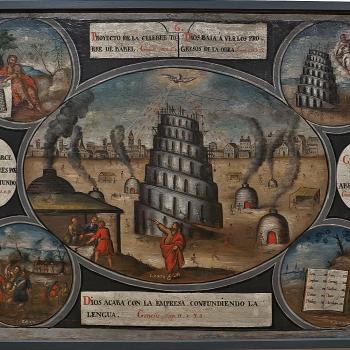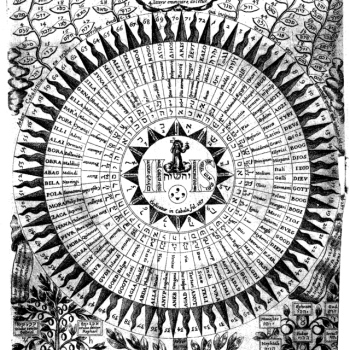
The incomprehensible God has revealed himself to us.
There are many ways in which this can be said to be true.
We could talk about the divine energies, and the way we come to know God in and through his works; by following this route, it can be said that we know God, not face to face, but rather, by receiving a glimpse of his glory from his back (cf. Ex. 33:18-23).
Likewise, God reveals himself through the incarnation, and in the incarnation, we learn that the One God is also, mysteriously, three: Father, Son and Holy Spirit. In the Spirit, we are led to the Father through the Son. Here, the mystery of the Trinity is the mystery of how God can be absolutely simple and one (cf. Deut. 6:4) and yet three. There are many ways in which the Trinity is explained, but all of them must be understood as through human conventions which do not and will not comprehend the truth as it is in God himself. Some conventions are better than others, but all of them falter; even talk about God as one fails to represent who God is because even that “oneness” places a limit upon God according to the way we view such oneness and then try to comprehend God based upon what we think that oneness entails.
Nonetheless, an invaluable way in trying to understand the Trinity of divine persons is through appropriation, using examples from human conventions and the vestiges of God’s image in his creation as a means of understanding how something can be seen to be both multiple (or three) and one at the same time. This is done by finding ways to discuss each of the persons in a distinct fashion while finding how they can be said to be one God. To use such conventions, as with all conventions, we must be aware of their limitations. God is simple and one, and so not composed of parts; conventions often break down the Trinity into three different parts which come together as one, such as we find with a three-leaf clover, so that though we get a sense of their oneness, we lose divine simplicity. This does not mean such conventions should be abandoned; rather this means we must acknowledge their insufficiency even as they help us grasp after a transcendent truth.
How do we know what kinds of appropriations can we use to discuss God? ? By trying to find ways in which we can attribute particular qualities or characteristics to particular persons of the Trinity. This, of course, is done through analogy, where we find something in the economy of the revelation of the Trinity which makes us consider a particular quality or characteristic is fitting to that particular person. St. Thomas Aquinas, representing this tradition, explained:
For although the trinity of persons cannot be proved by demonstration, as was above expounded (Q.31, A.1), nevertheless it is fitting that it be declared by things which are more known to us. Now the essential attributes of God are more clear to us from the standpoint of reason than the personal properties; because we can derive certain knowledge of the essential attributes from creatures which are sources of knowledge to us, such as we cannot obtain regarding the personal properties, as was above explained (ibid.). As, therefore, we make use of the likeness of the trace or image found in creatures for the manifestation of the divine persons, so also in the same manner do we make use of the essential attributes. And such a manifestation of the divine persons by the use of the essential attributes is called appropriation.
The divine person can be manifested in a twofold manner by the essential attributes; in one way by similitude, and thus the things which belong to the intellect are appropriated to the Son, Who proceeds by way of intellect, as Word. In another way by dissimilitude; as power is appropriated to the Father, as Augustine says, because fathers by reason of old age are sometimes feeble; lest anything of the kind be imagined of God.[1]
Often, Scripture is employed in trying to establish such appropriations, such as when the Son is called the “wisdom and power of God.” This appropriation helps demonstrate the generation of the Son from the Father: The Father, in his thinking, is said to produce the Logos; in this fashion, God the Son is represented as his thought or word. Sadly, when this is followed to its literal conclusion, this leads many to think that the Father himself is not wise or powerful. If the Son is Wisdom, and the Father is not the Son, then the Father is not wise: he is wise only insofar as he has his Son, but of himself he is not wise. This, then, leads to a view of the persons of the Trinity as being unequal, where each has some natural good that the others do not possess.[2]
There are many ways the Trinity of persons can be, and are, given some order with each other through appropriation, such as relating them to: power, wisdom, and goodness; omnipotence, wisdom, love; goodness, truth, beauty; or finally, memory, intellect, and will. In each representation a unity between the three is expressed, so that a discussion can be had as to how three persons are one God. For example, the transcendentals of goodness, truth and beauty are seen as one, so that the truth is said to be good, and what is good is said to be beautiful, and yet realizing this, the distinction between the three remains, allowing then the Father to be said to be represented by the “good,” the Son to be represented by “the truth,” and the Holy Spirit to be seen as “beauty.” The problem mentioned above remains: does that mean the Father is not truthful, the Son is not good, and the Holy Spirit is neither truthful or good? Obviously not. The appropriations are useful in showing us how three can relate together as one, and even, possibly, give us a way to approach each person of the Trinity, as there might be a reason by which we apprehend each person better according to its particular appropriation. This is why we must not essentialize the appropriations, for if and when we do such, we would falsify the truth God revealed about himself to us in the revelation of the Trinity: the three persons are the same nature, and the distinctions must be seen as relative and not essential. We can use characteristics which are essential, that is, coming from the divine nature, for establishing our appropriations, but when we do so it is best to see the person who it is appropriated to best reveals that quality of the divine nature, and not say that such a person is the only one in which that quality of the divine nature exists. The Trinity of persons are not distinguished by essential qualities, only relative ones, that is, according to their relationship with each other (traditionally, this is often expressed by saying the Father is unoriginate, the Son is begotten of the Father, and the Spirit proceeds from the Father, to show that their relations are related to and through the Father).
One interesting way in which the appropriations have been established relates on to the Son and the Holy Spirit. They are said to be the “two revealing hands” of the Father, and so through them the quality and character of God, and therefore of the Father, is revealed. This notion is used to connect with the Genesis story explaining the creation of humanity in Genesis, where humanity is said to be made in the image and likeness of God:
This is the book of the generations of Adam. When God created man, he made him in the likeness of God. Male and female he created them, and he blessed them and named them Man when they were created (Genesis 5:1-2 RSV).
God’s image is revealed in and though the whole of humanity, represented by “male and female.” As there are two revealing hands of the Father, then the Son and Spirit are sometimes seen related to the production of male and female in humanity, where “male” is appropriated to the Son, and “female” is appropriated to the Spirit. There is much value which can come out of this, but like all appropriations, there is also great danger in that some can essentialize these appropriations when gender is essentialized into God and the Son is entirely seen as male without femininity, and the Spirit is seen as feminine without masculinity. This is not what is intended nor what should be established by this form of appropriation: there is no gender in God; all genders can be seen as justly represented by ever person of the Trinity. Men and women can see themselves in the Father, Son and Holy Spirit. Why, then, can this appropriation be made? Because of the incarnation, where the Logos assumed human nature as a man, and the Spirit overshadows the Virgin Mary and reveals itself through Mary. As with all appropriations, the manner of revelation makes it suitable but also with all appropriations, we must avoid turning what we see through it into an absolute, which is what would happen if the appropriations are essentialized.
UUnderstanding how the unity of God requires us to not misappropriate the relations of the Trinity into essential differences has ramifications for humanity. We are made in the image and likeness of God. Human nature reflects divine nature. Human nature is one despite the diverse persons established in and through it. Each person has their own hypostatic existence, their own relationship with everyone else and their common humanity. Just as it is dangerous and erroneous to essentialize the appropriations in the Trinity, so it becomes dangerous and erroneous to essentialize personal distinctions in humanity, to form divisions and essentialize them based upon the relative reality of human relations. Christ, in his humanity, shows the oneness of humanity, where such distinctions are shown to be relative, so that in him there is neither male nor female, Greek or Gentile, not because there are no relative distinctions between human persons but because those distinctions must not be elevated into essential differences. For if such essentialization is done, humanity is divided, and no longer one. There would be no common human nature. There would be no human nature for God to assume. Likewise, when we essentialize such division, they would turn us away from justice; when distinctions are essentialized, they are used to create ontological distinctions between peoples in order to justify abuses towards others. Whatever relative distinction is elevated to an ontological one allows for some to be seen as greater than others, justifying an erroneous social order which, as a result, will allow for and create injustices. For whatever is seen as an essential difference is used to destroy the common bond of humanity, the love which should hold us together as one. Once that love is lost, injustice follows. This should not be surprising, for sin creates division in order to eat away and destroy what is good, dividing it into distinct parts which then can be further divided until it is all made into nothing. Christ came to heal that division, to bring us back together, to make us one: indeed, as Julianus Pomerius explained of the state of the blessed in eternity: “There all, whoever they are, will be one body; and each one will rejoice in his own and everyone else’s happiness.”[3] This would be impossible if relative distinctions should be essentialized.
God has revealed himself to us. God has shown us to be three and one. But in the process, God has shown us more: God has shown us ourselves. God has shown us the unity of humanity, the unity which we must embrace if we want to be united with God. In showing us the Trinity, God has shown us the error of essentializing relative distinctions, not just in the Trinity, but in creation itself.
[1] St. Thomas Aquinas, Summa Theologica. Trans. Fathers of the English Dominican Province. I-xxxix.7.
[2] See St. Augustine, On the Trinity in NPNF1(3): 96.
[3] Julianus Pomerius, The Contemplative Life. Trans. Mary Josephine Suelzer, PhD (Westminster, MD: The Newman Bookshop, 1947), 31.
Stay in touch! Like A Little Bit of Nothing on Facebook.
If you have liked what you read, please consider sharing it with your friends and family!













